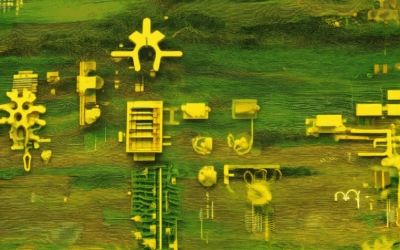In today’s rapidly evolving world, the intersection of technology and creativity stands as a cornerstone of progress and innovation. While many view technology as a tool that constrains creativity, the truth could not be more opposite. Business creativity in technology emerges as a powerful catalyst, driving advancements that transform industries and economies. From groundbreaking products to revolutionary services, creativity in the tech sector has redefined how businesses operate and compete. This article delves into the intricate dance between technology and creativity, exploring how business creativity shapes technological breakthroughs and why it remains essential in our fast-paced digital age. By examining case studies, strategies, and real-world applications, we’ll uncover the vital role of creativity in fostering innovation and explore how businesses can harness this dynamic force to thrive in an ever-changing landscape.

How Does Technology Contribute to Creativity?
Technology has become an integral catalyst for fostering creativity, enabling individuals and teams to explore innovative ideas and bring them to life. By providing advanced tools, platforms, and frameworks, technology democratizes access to resources that were once reserved for select artists, designers, and inventors. Here’s a breakdown of how technology contributes to creativity:
1. Enhanced Tools for Idea Visualization
Technology equips creators with powerful tools that allow them to visualize complex concepts and communicate ideas effectively. Digital design software, such as Adobe Creative Suite or Canva, empowers designers to create stunning visuals and iterate quickly. Similarly, 3D modeling software like Blender or SketchUp enables spatial thinkers to craft intricate three-dimensional designs.
2. AI-Powered Idea Generation
Artificial intelligence is revolutionizing creativity by offering suggestions and inspiration. AI tools like MidJourney or Stable Diffusion can generate visual ideas based on textual descriptions, helping artists overcome creative blocks. Moreover, AI-driven platforms like ChatGPT facilitate brainstorming sessions by providing diverse perspectives and potential solutions to problems.
3. Collaboration and Feedback Loops
Technology bridges geographical gaps and fosters global collaboration among creatives. Platforms like Slack or Microsoft Teams enable real-time teamwork, allowing designers and writers to work together seamlessly. Additionally, feedback loops are accelerated through tools like InVision or Figma, enabling rapid iteration and refinement of creative concepts.
4. Data-Driven Creativity
By leveraging big data and analytics, creators can identify emerging trends and consumer preferences. Tools like Google Trends or Statista provide valuable insights into what resonates with audiences, guiding content creation in alignment with market demands. This data-driven approach ensures that creativity is grounded in real-world needs and opportunities.
5. Accessibility and Democratization
Technological advancements have made creative tools accessible to everyone. Mobile apps like Procreate and iPad Pro have brought professional-grade creative tools to hobbyists and aspiring artists. Online platforms like YouTube and Udemy offer tutorials and courses, making it easier for individuals to learn and master creative skills previously reserved for experts.
6. Preservation and Sharing of Creativity
Technology plays a vital role in preserving and sharing creative works. Cloud storage solutions like Google Drive or Dropbox enable easy backup and access to projects. Digital portfolios on platforms like Behance or Dribbble showcase work to potential employers or collaborators, expanding the reach and impact of individual creations.
7. Future Trends in Creativity
As technology continues to evolve, its role in creativity will become even more integral. Virtual reality (VR) and augmented reality (AR) are opening new avenues for immersive storytelling and design experiences. Additionally, generative AI is expected to complement human creativity, offering new ways to prototype ideas and explore creative possibilities.
In conclusion, technology is not just a tool for creativity—it is a multiplier, amplifying human potential and enabling creativity on a scale never seen before. By harnessing the power of technology, we unlock new dimensions of creativity, driving innovation across industries and shaping the future of our world.
What is Business Creativity?
Business creativity refers to the ability of an organization or individual to generate novel ideas, approaches, or solutions that drive innovation and growth. It involves thinking outside traditional boundaries, exploring unconventional methods, and developing unique strategies to achieve business objectives. Creativity in a business context is essential for staying competitive, adapting to market changes, and delivering value to customers.
The Importance of Business Creativity
- Innovation : Creativity is the cornerstone of innovation. It enables businesses to develop groundbreaking products, services, or processes that differentiate them from competitors.
- Efficiency : By approaching problems creatively, businesses can often find more efficient solutions, reducing costs and optimizing resource usage.
- Customer Satisfaction : Creative ideas can lead to tailored offerings that better meet customer needs, resulting in higher satisfaction and loyalty.
- Adaptability : In dynamic markets, creativity allows businesses to pivot quickly, embracing new trends and responding effectively to challenges.
- Team Morale : A creative work environment can foster collaboration and inspire employees, leading to higher morale and productivity levels.
Examples of Business Creativity
- Innovative Products : Companies like Airbnb and Tesla have revolutionized their industries through highly creative product designs and service models.
- Unique Marketing Strategies : Brands such as Dollar Shave Club and Blue Apron have used humor and personalization to capture market share.
- Sustainable Practices : Patagonia and Ben & Jerry’s use creative approaches to promote environmental responsibility.
- Remote Work Solutions : Zoom and Slack transformed remote work through innovative communication tools that improved productivity and collaboration.
Challenges in Business Creativity
Despite its benefits, creativity in business can face barriers such as:
– Fear of failure or criticism
– Lack of resources or knowledge
– Resistance to change within organizations
– Time constraints and pressure to deliver results
How to Foster Creativity in the Workplace
To encourage creativity, businesses should:
– Provide open environments that encourage experimentation
– Offer training and resources for skill development
– Promote diversity of thought and perspectives
– Set clear goals while allowing flexibility
– Celebrate and reward innovative ideas
By nurturing creativity, businesses can unlock significant potential, driving growth and achieving long-term success in competitive markets.

Creative Things in Technology
- Augmented Reality (AR) and Virtual Reality (VR)
- Artificial Intelligence (AI) and Machine Learning
- Wearable Technology
- Smart Homes and IoT Devices
- 3D Printing and Additive Manufacturing
- Robotics and Autonomous Systems
- Blockchain and Decentralized Applications
- Personalized Learning Systems
- Interactive Gaming Experiences
These innovations demonstrate the boundless creativity in technology, driving advancements across industries and shaping our daily lives.
Examples of Creative Technologies
- Augmented Reality (AR): Enhances reality through digital overlays, enabling applications in gaming, education, and healthcare.
- Virtual Reality (VR): Creates immersive environments for training, entertainment, and therapeutic purposes.
- AI-Powered Chatbots: Provide intelligent conversations and assistance across various platforms and services.
- Wearable Fitness Trackers: Monitor health metrics and promote active lifestyles through real-time data tracking.
- Smart Speakers: Enable voice-controlled interactions and integrate with smart home systems for convenience.
- 3D Bioprinting: Prints living cells and tissues, revolutionizing medical research and tissue engineering.
- Autonomous Vehicles: Self-driving cars that navigate independently, reducing traffic accidents and optimizing transportation.
- Blockchain Technology: Secure, decentralized ledgers powering cryptocurrencies and supply chain management.
- Interactive Education Tools: Personalized learning experiences through adaptive software and gamified interfaces.
- Gaming Interfaces: Advanced controllers and VR headsets that immerse players in virtual worlds.

Why is Creativity Important in the IT Industry?
Creativity is essential in the IT industry for several reasons:
- Driving Innovation: Creativity is the catalyst for innovation, which is crucial in the tech sector. IT professionals use creative thinking to develop new technologies, improve existing systems, and solve complex problems. This imaginative approach leads to breakthroughs that drive progress and give companies a competitive edge.
- Problem-Solving: The IT industry frequently encounters unique challenges that require unconventional solutions. Creativity enables professionals to think outside the box, offering fresh perspectives to overcome obstacles and deliver effective results.
- Fostering Collaboration: Creativity thrives in collaborative environments, which is common in IT projects. Diverse ideas and perspectives from team members can lead to more innovative and efficient solutions, enhancing overall project outcomes.
- Adaptability: The rapid pace of technological change demands constant adaptation. Creative thinking allows IT workers to stay ahead of trends, embrace new tools, and evolve their skills, ensuring they remain relevant in a dynamic field.
- Personal Growth and Motivation: Engaging in creative activities enhances job satisfaction and keeps professionals inspired. Companies that nurture creativity often see higher employee engagement and lower turnover, as motivated teams contribute more effectively.
By embracing creativity, the IT industry can continue to push boundaries, drive technological advancements, and meet the ever-growing demands of the global market.
Why is creative technology important?
Creative technology is important because it empowers individuals to express themselves in innovative ways, fostering creativity and driving progress in various industries.
- Enhances Creativity: Creative technology provides tools and platforms that allow artists, designers, and innovators to explore new avenues of expression. Digital tools like graphic design software, 3D modeling, and virtual reality enable the creation of complex and immersive experiences.
- Drives Innovation: Technology often serves as a catalyst for innovation. Creative tools facilitate the development of groundbreaking ideas, products, and solutions that might otherwise be impossible or impractical.
- Educational Impact: Integrating creative technology into education can make learning more engaging and inspire students to explore diverse fields. Tools like interactive simulations and digital storytelling can spark curiosity and creativity in young minds.
- Fosters Collaboration: Creative technology enables teamwork across geographically dispersed teams. Platforms like cloud-based software allow real-time collaboration, resulting in diverse perspectives and more innovative outcomes.
- Democratizes Access to Art: Digital tools lower barriers to entry for creators. Platforms like YouTube, Instagram, and Canva make it possible for anyone with an idea to share their creativity with a global audience.
- Contributes to Personal Growth: Creative technology can aid in self-expression and personal development. Apps like journaling tools and mindfulness platforms help individuals reflect, connect with their emotions, and grow.
- Future-Proofing Society: As technology evolves, creative tools are essential for addressing global challenges. They encourage innovative thinking and adaptability, helping societies adapt to changing circumstances.
- Enriches Communication: Creative technology enhances storytelling and information sharing. Videos, animations, and interactive content make complex ideas more accessible and engaging for a broader audience.

Why is Creativity Important?
- Personal Growth and Self-Discovery
Creativity serves as a tool for self-expression and personal development. By exploring new ideas and perspectives, individuals can gain deeper insight into their passions and strengths. This process fosters resilience and helps people overcome challenges, ultimately leading to greater self-awareness and confidence. - Problem-Solving and Innovation
Creativity is instrumental in addressing complex problems and driving innovation. Businesses and industries rely on creative thinking to develop novel solutions and stay competitive. Companies like Iterati leverage creativity to deliver cutting-edge strategies and transform traditional approaches into modern, effective practices. - Emotional Intelligence and Connection
Creativity fosters empathy and understanding, allowing individuals to connect with others on a deeper level. Through storytelling, art, or design, creative expression can convey emotions and ideas that words alone cannot. This ability enhances relationships and cultural exchange, making creativity a bridge between diverse perspectives. - Societal Progress and Cultural Richness
Creativity contributes to the evolution of society and culture. From technological advancements to artistic movements, creative efforts shape our world. Platforms like Iterati highlight the importance of creativity in driving progress, whether through sustainable solutions or digital transformation, ensuring a brighter future for generations to come. - Resilience and Adaptability
In uncertain times, creativity helps individuals adapt and thrive. It enables problem-solving in dynamic environments and keeps minds sharp during challenges. By embracing creativity, we develop flexibility and the ability to pivot, which are essential skills in today’s rapidly changing world.
Conclusion
Creativity is a cornerstone of human potential, driving personal and societal advancement. By nurturing creativity, we unlock innovative solutions, foster meaningful connections, and contribute to a richer, more inclusive world.




0 Comments